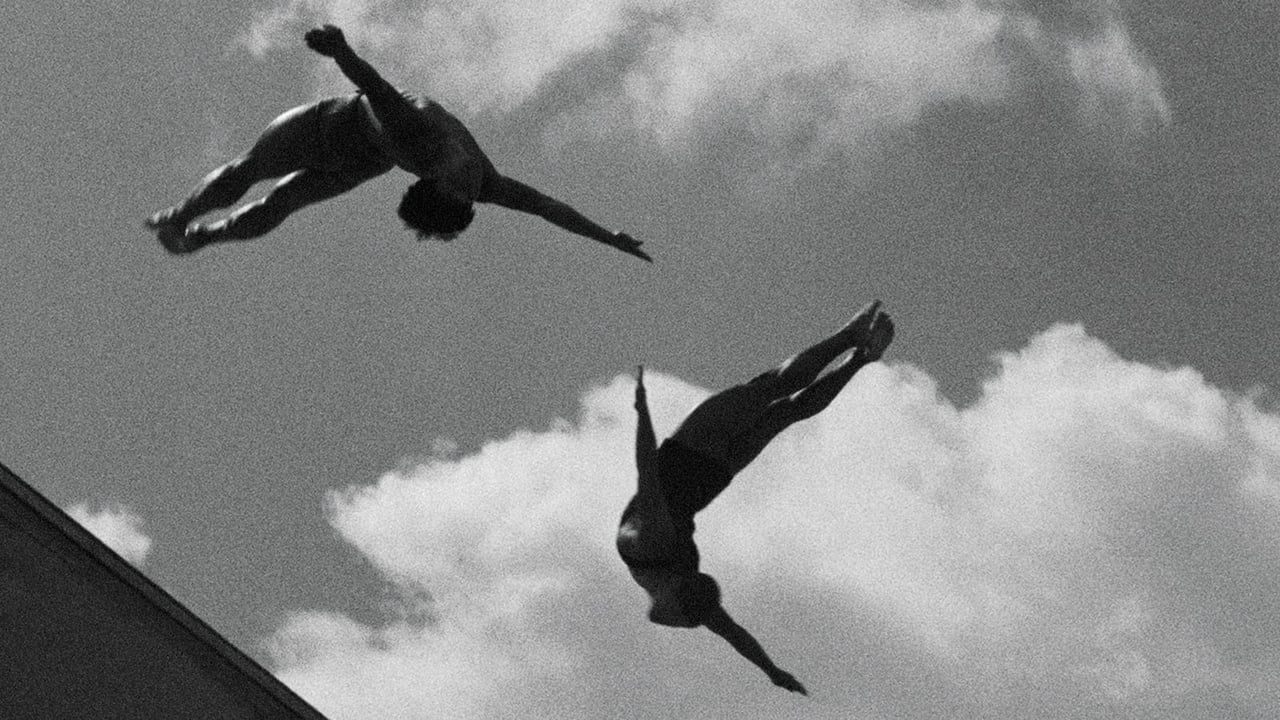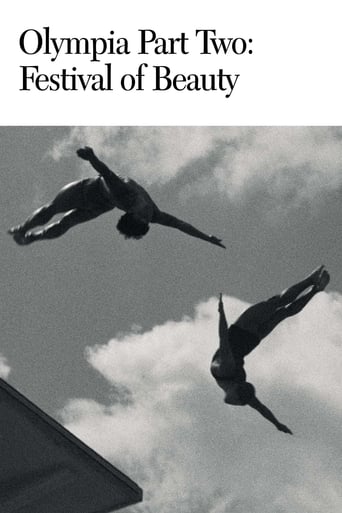


The 80-year-old, 90-minute "Olympia 2. Teil - Fest der Schönheit" or "Olympia Part Two: Festival of Beauty" is centenarian Leni Riefenstahl's sequel to "Olympia 1. Teil - Fest der Völker" and this one here focuses more on beauty as the title already says. However, that did not keep Riefenstahl from adding sports such as rowing. Oh well, some may even find this beautiful from an aesthetic perspective. But seriously, stuff like high diving included here justifies the title, even if there are certainly better ways to categorize what is in the first film and what is in here. The choice that makes probably the most sense is that athletics were in the first film and everything else is in here, such as cycling, fencing, football and a lot more. And just like with the first, it is once again a fairly neutral documentary, no propaganda like some of the films Riefenstahl made before the Olympic Games of 1936. French, British and American winners are shown. And this film is also after Riefenstahl's acting career. She had been Hitler's favorite filmmaker for a while already when she made this film. I must say I enjoyed this sequel, but not as much as the first. The closing ceremony at the end of the first film seemed like decent closure to the subject, but yes there is another film. It runs roughly 30 minutes shorter than the first though. But I guess it is okay, justice done to the winners and competitors that weren't show in the first film. Overall, this is an inferior sequel as it maybe tries to include too many sports in too little runtime and lacks further elaboration on the champions and contests, something I really liked about the first. Nonetheless, this was a really good watch and I recommend checking it out. Also one of the most defining sports documentaries in history. Thumbs up.
... View MoreThis is an even more beautiful looking documentary than was the case with the first Riefenstahl 1936 Olympics documentary "Olympia 1. Teil - Fest der Völker". Perhaps it's because this movie focuses more on the more gracious looking sports, than was the case in the first movie, which focused purely on the sports being played within the Olympic stadium. Or perhaps it's also because the Netherlands actually won some gold medals in this part ;). This movie mostly focuses on all of the other sport being played outside of the stadium, indoors and outdoors. Sports such as fencing, boxing, swimming, hockey and everything else you can expect during the Olympics. Most sports are still featured now days at the Olympics. It's of course great seeing all those rs and how they were being played back then in 1936. Some things (for the better) have really changed.Because of the more wide diversity of sports, the documentary also seems like it's going faster as well. Basically every 5 minutes we get to see a completely different sport, being set also at a totally different location again. It also perhaps makes all more exciting to watch as well.Just like "Olympia 1. Teil - Fest der Völker" it's a beautifully shot documentary, that set the standards for future documentary making. Leni Riefenstahl was a real pioneer in documentary making, regardless of what you think of her motives. Many of the used techniques are now common to the filming of sports.This movie also definitely feels less propaganda like than was still the case with "Olympia 1. Teil - Fest der Völker". It still remains a weird sight though, seeing German officers helping out the athletes, as Olympic officials. This of course got very all well organized and planned out by Nazi authorities, which basically used the 1936 as one big piece of propaganda. At least it doesn't show as much of Hitler (actually no Hitler at all) and Nazi flag waving as was the case in the first part.A great and important achievement in the filming of sport and documentary making in particular, from Leni Riefenstahl.9/10http://bobafett1138.blogspot.com/
... View More***warning: spoliers (of a sort)*** This is certainly the better of the two Olympia films, as others have noted, though some sequences are more interesting than others. Gymnastics gets its turn - not surprising, as Riefenstal trained as a gymnast - as do equestrian events, all-too- brief coverage of cycling, and a few too many yachts. This is the film with the diving, as others have noted, and it is not possible to overstate how brilliantly edited that sequence is.That sequence, along with the gymnastics which open the film, is the heart of "Olympia"'s rather complex connection with Nazi ideology. Watch these sequences, and notice how the athletes' connection with the ground is removed. The extreme slow motion and rhythmic editing take this beyond a celebration of beauty; it is a celebration of transcendence, the creation of an image of man larger than the world. The diving sequence at the end disolves into an idealized vision of Speer's Cathedral of Light, and the film ends with clouds, flags, flame, and a ladder of lights that pierces the sky. Together with Windt's underrated score, this film is one of the best examples of German Romanticism ever created. That idealization and transcendence, the piercing of matter to get at the spirit behind it, *was* a component of Nazi ideology, and Riefenstahl, who was not a member of the party (and, to be fair, seems to have been repelled by the Nazi's racism) was a fellow Romantic.Is it worth seeing today? Undoubtedly so, if only to see where modern sports coverage got its start. Think about those more complex connections, though.
... View MoreRarely -- perhaps never before or since -- has the sheer beauty of the human body and the joy in its perfection been as well captured as in in "Olympia, Festival of Beauty". Watching this is film is to capture some sense of what the Ancient Greeks meant when they discussed _arete_ -- the "virtue" of being "beautiful" in body and soul. The great Humanists of the Renaissance would have been honored to count Miss Riefenstahl among their number had they been able, by some miracle, to see this canvas of Beauty in motion. As art, this film ranks with the works of Michaelangelo, Donatello, Phidias, and others who have scaled the empyrean heights and seen Humanity looking back at them. Poignant is the dolorous thought that within a few years so many of these paragons of _arete_ would be killed in the War. It is no wonder that Joseph Goebbels was said to have disliked Riefenstahl -- while she (even in "Triumph of the Will") held a mirror to the beauty of humanity and its highest aspirations, he dredged up the most noxious evils of the soul and twisted them into images of fear & horror; while she emphasized unity and camaraderie, he stressed division & distrust in order to secure his own vile position under the Fuhrer whom they both viewed so differently. Miss Riefenstahl portrayed people of all races and nations at the most sublime pinnacle of their own perfection, while a few years later Walt Disney and the Warner Brothers gave us buck-toothed Japanese midgets and paunchy German robots as The Inhuman Enemy. Today, however, it is SHE who is reviled. The more things change ... the more they remain the same
... View More